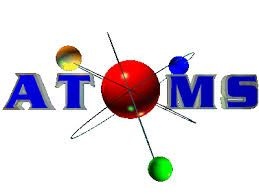An atom is the smallest unit of matter that defines the chemical elements. Every solid, liquid, gas, and plasma is made up of neutral or ionized atoms. Atoms are very small: the size of atoms is measured in picometers—trillionths (10−12) of a meter.[1]
Every atom is composed of a nucleus and one or more electrons that orbit the nucleus. The nucleus is made of one or more protons and typically a similar number of neutrons (none in hydrogen-1). Protons and neutrons are callednucleons. Over 99.94% of the atom's mass is in the nucleus.[2] The protons have a positive electric charge, the electrons have a negative electric charge, and the neutrons have no electric charge. If the number of protons and electrons are equal, that atom is electrically neutral. If an atom has a surplus or deficit of electrons relative to protons, then it has an overall positive or negative charge, and is called an ion.
Electrons of an atom are attracted to the protons in an atomic nucleus by this electromagnetic force. The protons and neutrons in the nucleus are attracted to each other by a different force, the nuclear force, which is usually stronger than the electromagnetic force repelling the positively charged protons from one another. Under certain circumstances the repelling electromagnetic force becomes stronger than the nuclear force, and nucleons can be ejected from the nucleus, leaving behind a different element: nuclear decay resulting in nuclear transmutation.
The number of protons in the nucleus defines to what chemical element the atom belongs: for example, all copperatoms contain 29 protons. The number of neutrons defines the isotope of the element.[3] The number of electrons influences the magnetic properties of an atom. Atoms can attach to one or more other atoms by chemical bonds to form chemical compounds such as molecules. The ability of atoms to associate and dissociate is responsible for most of the physical changes observed in nature, and is the subject of the discipline of chemistry.
Not all the mass of the universe is composed of atoms. Dark matter comprises more of the Universe than matter, and is composed not of atoms, but of particles of a currently unknown type. Also, the classical physics of Newton does not explain many of the properties and behavior of atoms and sub-atomic particles: the field of quantum mechanics has been developed to better do so.



